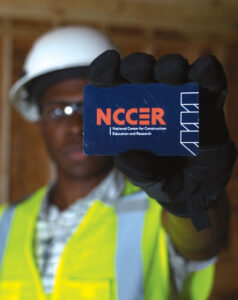Construction Credentials: Why Do They Matter?
Credentials matter. It is understood across the construction industry that training credentials are important and are a vital part of our educational system. As interests and opinions shift about bachelor’s or master’s degrees being the path for all, other forms of industry credentials remain key options for workforce development. In the construction industry, credentials pave the way for lucrative careers, job satisfaction and highly sought after skills.
What is a credential?
 Merriam-Webster defines a credential and credentials in a few ways — a credential is “something that gives a title to credit or confidence” as well as a “certificate or diploma,” and credentials are “testimonials or certified documents showing that a person is entitled to credit.
Merriam-Webster defines a credential and credentials in a few ways — a credential is “something that gives a title to credit or confidence” as well as a “certificate or diploma,” and credentials are “testimonials or certified documents showing that a person is entitled to credit.
The Association for Career and Technical Education states that education- and work-related credentials “verify an individual’s qualifications or competence and are issued by a relevant third party.”
In the construction industry, it is important not to get credentials and certifications confused. Because the terms are similar — and many times used interchangeably — there can be confusion about what they mean. Although other industries may use these terms differently, in construction, we view a credential as a building block within a training program to show competency of skills and knowledge.
However, certifications generally represent journey-level knowledge and skill of a specific craft. For example, a certified electrician would typically go through training and would also have three to four years of experience in that craft before completing the written and performance journey-level assessments. Training credentials are a valuable stepping-stone in a person’s career path that can ultimately lead to certification.
Why are credentials important?
The 2018 research report, “Restoring the Dignity of Work: Transforming the U.S. Workforce Development System into a World Leader,” found that for every ten jobs available in the United States, only one required a master’s degree or higher, two required a bachelor’s degree or higher, and seven needed a credential, certificate or an associate’s degree.
These figures are reinforced by recent data from employment sites, with fewer than 1-in-5 U.S. job postings on Indeed (17.8%) and ZipRecruiter (14.5%) requiring a four-year degree. Companies are prioritizing skills over degrees, with 72% of employers saying they practice skills-based hiring.
The 1:2:7 ratio is key to building a successful workforce development system in the U.S., but it may be unknown by many students and their parents, in part because of the common misconception that a college degree is the guaranteed route to success. This belief has contributed to more students pursuing degrees than what the labor market needs, resulting in 52% of bachelor’s degree holders being underemployed one year after graduation, according to a report by Burning Glass Institute and Strada Institute for the Future of Work.
While 45% of bachelor’s degree holders remain underemployed a decade after graduation, the construction industry still has many opportunities for careers that are, and will continue to be, in high demand. The sector is facing an estimated skilled labor shortage of 2.6 million through 2028, as reported by the Construction Labor Market Analyzer.
The construction industry also has an older-than-average workforce, and projections indicate the average age is continuing to rise. Although younger talent is needed in the industry now to prepare for retiring baby boomers, currently, most members of the younger generations do not consider construction as their first career choice. A challenge the industry faces is to show that construction can be a primary and lucrative career option for all individuals entering the workforce.
One way to illustrate the benefits of jumpstarting a career in construction is through apprenticeships and craft training programs, where individuals can become credentialed and certified while accruing little-to-no debt. There are even scholarships available for those in training programs.
Promote earning credentials.
Industry and education must work together to promote the value of earning credentials and to create the most impact for both students and the construction workforce.
One partnership that has been successful is Sundt Construction and Central Arizona College (CAC). Sundt Construction was struggling to find skilled craft professionals while CAC’s construction discipline courses were decreasing in enrollment. Sundt and CAC were able to identify five craft pathways specifically designed to provide OSHA 30, stackable certifications equaling 30 college credit hours, and NCCER Level 1 and 2 credentials for specific crafts. With the commitment from both the contractor and college leadership, the program was put into place in three months.
The growing attention that credentials are receiving is important, especially as it highlights the importance of career and technical education to grow talent in construction. The construction workforce has an opportunity to encourage students to pursue credentials and career options they may not have considered, and to support the programs where young people are learning the skills our construction workforce needs.
Learn how NCCER’s industry-recognized credentials are helping to advance careers in construction.
Interested in receiving more great construction news, research and content from NCCER? Click here to join our mailing list!

